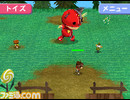|
|

|
PLATFORM
|
DS
|
BATTLE SYSTEM
|

|
INTERACTION
|

|
ORIGINALITY
|

|
STORY
|

|
MUSIC & SOUND
|

|
VISUALS
|

|
CHALLENGE
|
Easy
|
LANGUAGE BARRIER
|
Moderate
|
COMPLETION TIME
|
Less than 20 hours
|
|
OVERALL

|
+ Easy to pick up and play.
+ Cute environments that follow the motif well.
+ Splash screens and voice acting work well.
- Too easy for experienced players.
- Doesn't take full advantage of its plot.
- Most weapons and toys are superfluous.
|
Click here for scoring definitions
|
|
|
There is a story in Japan, a tale of tricky foxes who pick up things that have been lost or abandoned. In August of 2009, a film based on this story arrived in movie theaters. Oblivion Island - Haruka and the Magic Mirror was a Burton-esque adventure through a junkyard Wonderland, but it's not what we're talking about today. This review is for Oblivion Island - Kanata and the Rainbow Mirror, the tie-in game released almost a month before the film.
Kanata, the hero of the game, is not a happy boy. As the story begins, he has just learned that his mother will have to work during his school's annual sports festival. This is a big thing for a second- or third-grade boy, and Kanata's sulky attitude over this becomes one of his defining character traits. To calm him down, his mom reads him a bedtime story about a magical island where lost and abandoned items go. Still angry, he declares himself to be abandoned, too. The world fades away, and he lands headfirst in a strange, new world.
If Haruka showed Oblivion Island as a sort of Wonderland, then Kanata's version is a picture-book, complete with chapters. To return home, he must find the seven colored mirrors scattered in various regions. Each adventure advances the story one page, with his mother providing narration between chapters. These narrated sequences, as well as the entire opening and final segments of the game, are illustrated with splash pages that provide a good deal of depth and humor for the story, moreso at least than could be expressed with the game's polygonal character sprites.
Kanata is a very basic action RPG, though one that makes decent use of stylus controls. It's easy to direct the young hero around the screen, and for the most part the controls do not add unnecessary challenge to the existing puzzle and platformer elements. Tapping in the general area of an enemy is enough to get Kanata whacking away with whatever oddball weapon he has at hand, and it isn't difficult to outmanoeuver enemies to get harder-hitting back attacks. This game does not suffer a dearth of weaponry, though it doesn't provide much reason to use most of the arsenal. There are plenty of weapons in the same general damage range at any given point in the game, so it really comes down to what the player feels like using. Some weapons have special attacks that can be toggled using a touchscreen button, and while these can be helpful in tight situations they aren't game changers. Aside from weaponry, there's no equipment to speak of. Kanata's clothes do have one special trait, however — since they're made from recycled paper, they are especially susceptible to water and fire damage, which helps explain how even small creeks can become insurpassable obstacles.
 Comically Violent Teddy Bears, Oh My!
Comically Violent Teddy Bears, Oh My!
|
|
Oblivion Island may as well have been named the Island of Misfit Toys, considering all the oddities that pop up. About half of the enemies in the game are variations on the main villain's robotic army, but the rest are groupings of lost toys that are understandably upset at the way their owners have forgotten about them. Still, many of these toys will choose to come with Kanata (or at least, will show up in treasure chests). So when the time comes to deal with water, fire, or electrical hazards, Kanata can pull out his toybox and send any two toys at a time to do his bidding. They can cross hazards, flip switches, and attack enemies, though their most useful feature in battle is to serve as decoys. Each toy has a timer that counts down from 100 as they wander around. This timer also doubles as hit points, so a strong hit by most any enemy late in the game will force them back into the toybox for a recharge. There are two-hundred seventy toys to find in the game. They can be bought from the store in town, found in set spots during a level, or (most often) they will be dropped by enemies. More notable types include various RC vehicles, Godzilla lookalikes, Mappy the Mouse action figures, and the little dude from Katamari Damacy.
Almost all of Kanata is done in polygonal 3D graphics, and often looks blocky and unfinished on the edges. The camera is usually static, but it will rotate around during boss battles to help keep the enemy properly in frame. In those instances, this can actually be helpful to the player. The bosses themselves are large and comical, and often require specific strategies in order to be beaten. Kanata's new best friend, Teo, is good at giving tips, and winning strategies aren't too difficult to figure out even when the player can't understand what he's saying.
For most of its length, this is an incredibly easy game. It is not uncommon for two or three enemies on the same screen to drop chests containing instant healing items, and Kanata gets healed in full at every (frequent) level up. It does get harder towards the end, with the last two levels introducing some fun platforming challenges as well as enemies that can take more than a few hits from even a high-end weapon. Still, from the tone of the game, the general learning curve, and the level of language used, it's obvious this title was targeted for younger elementary schoolers. The theme of the game — dealing with feelings of abandonment from busy parents — is definitely something that many kids in Japan can relate to, and it's too bad that more time was not spent on that in the game. As it is, Kanata clocks in at six and a half hours from start to finish, including all twenty of the side-quests and a majority of toys found.
 But Mooooooom...
But Mooooooom...
|
|
The game's soundtrack is easy on the ears, but mostly forgettable. No tracks really stand out, though it's possible that several of them were repurposed from the movie and simplified. The sound effects for general action are limited, however, and Kanata's battle grunts get old quickly. The game features an admirable amount of voice acting at the proper points, and several actors from Haruka and the Magic Mirror contribute some quality work.
Kanata and the Rainbow Mirror and its sibling movie both take a very important theme that resonates with the youth of Japan, but they do it in different ways. In the end, Kanata is just too short an experience to do it well, with gameplay that feels too simple most of the time and a story that could have been expanded upon much more than it was. It is an enjoyable diversion, but foreign players should not feel too excluded for never having the chance to try it out. Instead, I would highly recommend the movie, which did receive a foreign release and is easily found on Amazon.com. Of the two, it is the better experience.
Review Archives
|









